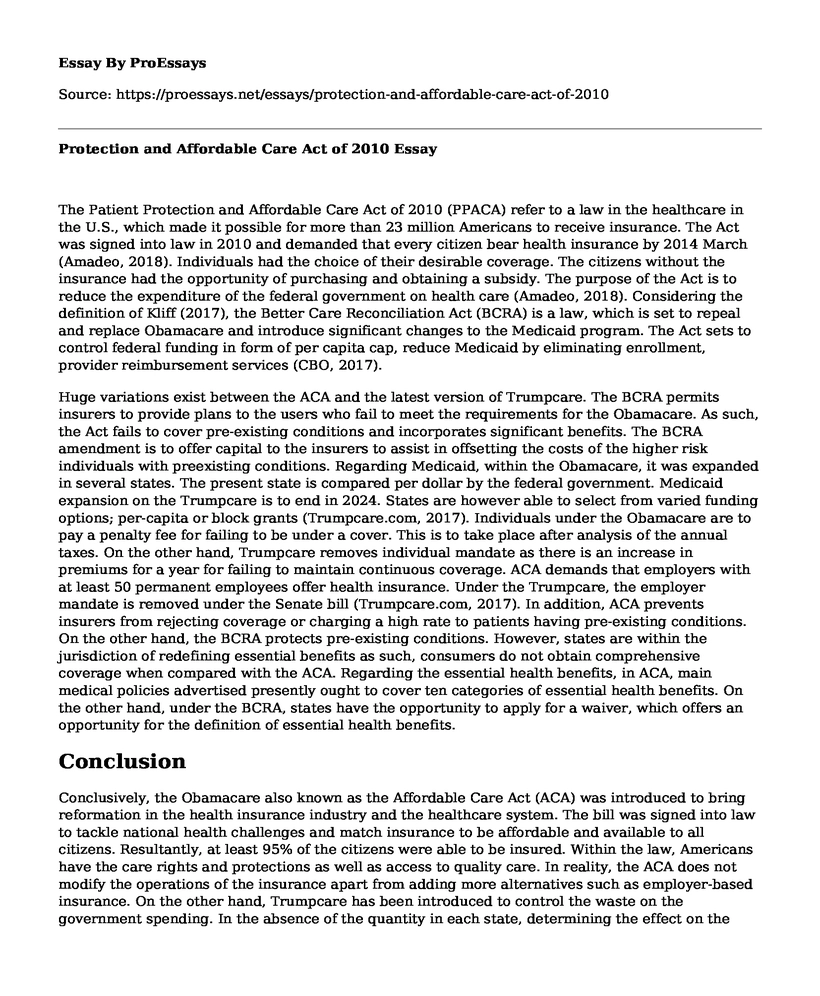The Patient Protection and Affordable Care Act of 2010 (PPACA) refer to a law in the healthcare in the U.S., which made it possible for more than 23 million Americans to receive insurance. The Act was signed into law in 2010 and demanded that every citizen bear health insurance by 2014 March (Amadeo, 2018). Individuals had the choice of their desirable coverage. The citizens without the insurance had the opportunity of purchasing and obtaining a subsidy. The purpose of the Act is to reduce the expenditure of the federal government on health care (Amadeo, 2018). Considering the definition of Kliff (2017), the Better Care Reconciliation Act (BCRA) is a law, which is set to repeal and replace Obamacare and introduce significant changes to the Medicaid program. The Act sets to control federal funding in form of per capita cap, reduce Medicaid by eliminating enrollment, provider reimbursement services (CBO, 2017).
Huge variations exist between the ACA and the latest version of Trumpcare. The BCRA permits insurers to provide plans to the users who fail to meet the requirements for the Obamacare. As such, the Act fails to cover pre-existing conditions and incorporates significant benefits. The BCRA amendment is to offer capital to the insurers to assist in offsetting the costs of the higher risk individuals with preexisting conditions. Regarding Medicaid, within the Obamacare, it was expanded in several states. The present state is compared per dollar by the federal government. Medicaid expansion on the Trumpcare is to end in 2024. States are however able to select from varied funding options; per-capita or block grants (Trumpcare.com, 2017). Individuals under the Obamacare are to pay a penalty fee for failing to be under a cover. This is to take place after analysis of the annual taxes. On the other hand, Trumpcare removes individual mandate as there is an increase in premiums for a year for failing to maintain continuous coverage. ACA demands that employers with at least 50 permanent employees offer health insurance. Under the Trumpcare, the employer mandate is removed under the Senate bill (Trumpcare.com, 2017). In addition, ACA prevents insurers from rejecting coverage or charging a high rate to patients having pre-existing conditions. On the other hand, the BCRA protects pre-existing conditions. However, states are within the jurisdiction of redefining essential benefits as such, consumers do not obtain comprehensive coverage when compared with the ACA. Regarding the essential health benefits, in ACA, main medical policies advertised presently ought to cover ten categories of essential health benefits. On the other hand, under the BCRA, states have the opportunity to apply for a waiver, which offers an opportunity for the definition of essential health benefits.Conclusion
Conclusively, the Obamacare also known as the Affordable Care Act (ACA) was introduced to bring reformation in the health insurance industry and the healthcare system. The bill was signed into law to tackle national health challenges and match insurance to be affordable and available to all citizens. Resultantly, at least 95% of the citizens were able to be insured. Within the law, Americans have the care rights and protections as well as access to quality care. In reality, the ACA does not modify the operations of the insurance apart from adding more alternatives such as employer-based insurance. On the other hand, Trumpcare has been introduced to control the waste on the government spending. In the absence of the quantity in each state, determining the effect on the population is an uphill task. As such, the population without the ability to afford health insurance is currently more affected. Conclusively, ACA regulated private insurance and resulted in reasonable pricing and coverage.
References
Amadeo, K. (2018). 2010 Patient Protection & Affordable Care Act Summary. The Balance. Retrieved from https://www.thebalance.com/2010-patient-protection-affordable-care-act-3306063Congressional Budget Office (CBO). (2017). H.R. 1628, Better Care Reconciliation Act of 2017. Retrieved from https://www.cbo.gov/publication/52849
Kliff, S. (2017). The Better Care Reconciliation Act: the Senate bill to repeal and replace Obamacare, explained. The Vox. Retrieved from https://www.vox.com/policy-and-politics/2017/6/22/15846728/senate-plan-better-care-reconciliation-actTrumpcare.com (2017). Trumpcare vs Obamacare. Retrieved from https://trumpcare.com/trumpcare-vs-obamacare
Cite this page
Protection and Affordable Care Act of 2010. (2022, Mar 29). Retrieved from https://proessays.net/essays/protection-and-affordable-care-act-of-2010
If you are the original author of this essay and no longer wish to have it published on the ProEssays website, please click below to request its removal:
- How Current Events Affected the Discussion About Gun Control in America? - Research Proposal
- Constitutional Law and Business Regulation Essay Exaample
- Victim Participation in the Criminal Justice System Essay Example
- Essay on San Quentin: Home of Serial Killers, Cop Killers and Child Killers
- Essay Example on the Harsh Childhood of H.H. Holmes, America's First Serial Killer
- On-Campus Students: Battling Crime and Social Evils - Essay Sample
- Prison Overcrowding: A Life-Threatening Problem - Essay Sample







